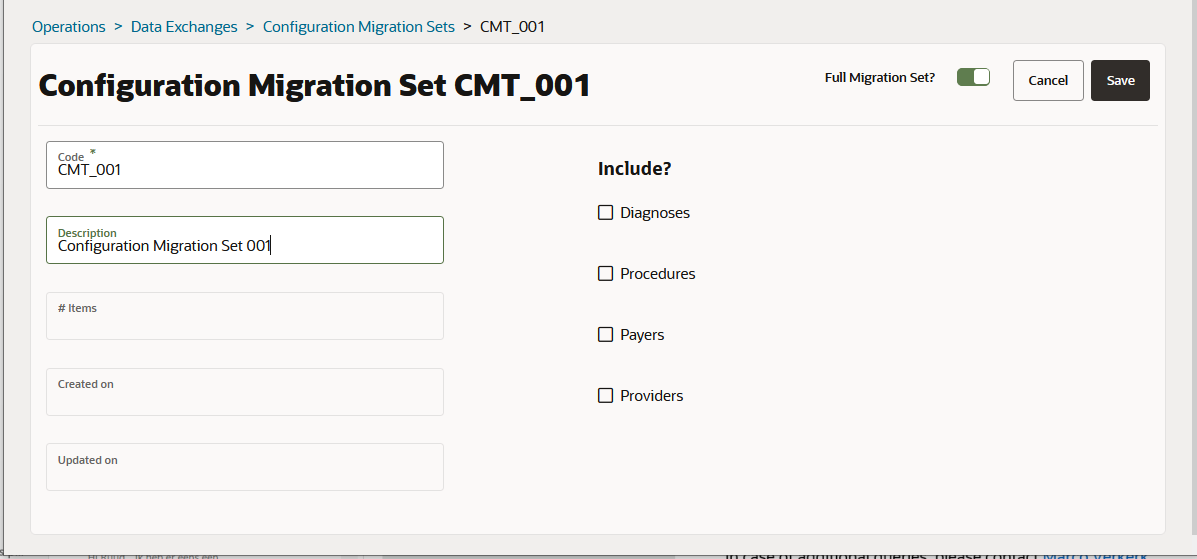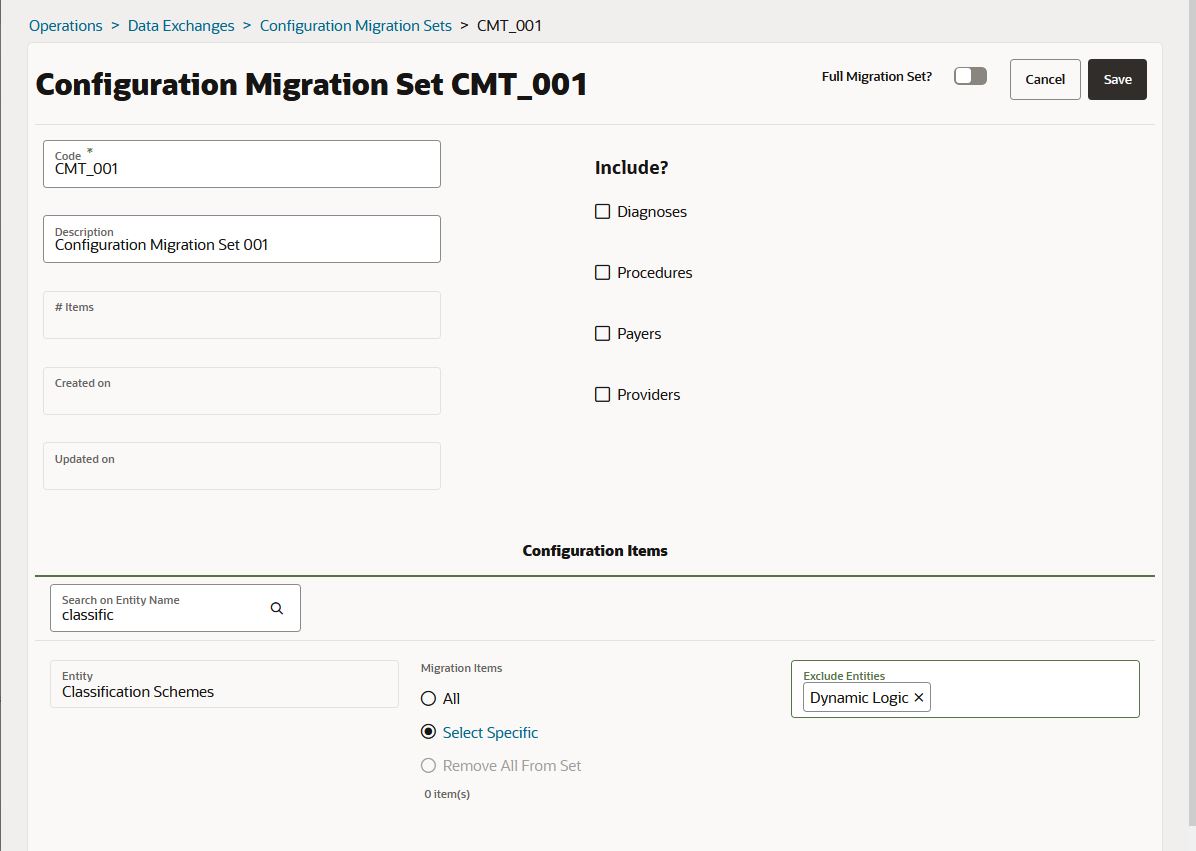Creating a Migration Set
Configuration Migration Sets
Configuration Migration Sets are assembled through a dedicated user interface page[1].
This page enables the user to select top level migration items, and include them in the set. It also provides several options that control whether relevant dependent items are included in the same set.
Unless explicitly included, the system excludes diagnosis, procedures, payers and providers from the migration set. These objects have their own data exchanges.

Including Configuration Items
Configuration rules in Oracle Health Insurance are hierarchical in nature; complex configuration rules are a composite of more basic configuration rules. For example, a process step is a composite of any combination of callout-, event-, pend- and validation rules. In turn, the pend rule is a composite of a dynamic logic condition and a message (and more) as well.
To facilitate the user in assembling a migration payload the migration function automatically determines what other configuration is required to successfully install the selected configuration item on the target environment.
The page offers the option to either create a full migration set or to include only a user-defined selection of the available configuration items in the migration set.
By default, a newly created migration set is a full migration set.
Switching the Full Migration Set? toggle, opens the Configuration Items section at the bottom of the page.
This section lists the items that are available for migration.

For each available configuration item the user can include all records or just a selection of records. The 'Remove All From Set' option removes all the records for this configuration item from the migration set.
Selecting the 'Select Specific' radio-button enables the 'Select Specific' link to a window where the user can select one or more records.

Below is the list of configuration items that can be included in a configuration migration data set. Each entry mentions which dependent items are auto-included and which dependent items can be excluded as an option.
| Top Level Item | Automatically Includes | Optional Excludes |
|---|---|---|
access role |
access restriction |
claim form |
activity type |
dynamic field usage[2] |
- |
address type |
- |
- |
advice response definition |
- |
dynamic logic |
authorization form |
- |
- |
authorization regime |
authorization regime period |
dynamic logic |
basket |
basket detail |
- |
benefit specification |
benefit priority |
authorization regime |
boilerplate text |
- |
- |
bundled amount |
bundled amount category |
message |
callout definition (displayed as claim callout rule in the UI) |
claim callout rule |
classification scheme |
case definition |
ancillary inclusion rule |
diagnosis group |
charged amount |
charged amount classification |
dynamic logic |
claim event rule |
claim event rule form |
claim form |
claim form |
claim form type |
flex code system |
claim transaction event rule |
- |
dynamic logic |
classification scheme |
brand |
claim form |
combination check |
combination check claim form |
claim form |
contract reference |
- |
- |
country |
bank account validation |
dynamic logic |
country region |
country |
- |
country region group |
country region group detail |
country region |
coverage regime |
count towards limit |
limit (displayed as adjudication limit in the UI) |
covered service tier |
- |
- |
currency |
- |
- |
derivation rule |
derivation rule form |
claim form |
diagnosis group |
diagnosis group detail |
- |
diagnosis type |
- |
- |
diminishing rate |
currency |
message |
dynamic check |
dynamic check claim form |
claim form |
dynamic field usage (displayed as usage in the UI) |
dynamic logic |
- |
dynamic logic |
dynamic logic reference sheet |
reference sheet |
eligibility response definition |
callout rule |
dynamic logic |
episode definition |
episode category |
diagnosis group |
exchange rate |
currency |
- |
external intervention rule |
brand |
claim form |
fee schedule |
classification |
contract reference |
fee schedule line[5] |
classification |
contract reference |
financial hold type |
- |
- |
flex code group |
flex code group detail |
flex code system |
flex code system |
dynamic logic |
|
floorplan |
floorplan tag details |
|
gender identity |
- |
- |
geographic region |
geographic condition |
dynamic logic |
identifiers type |
access restriction |
|
insurable entity type |
- |
- |
limit (displayed as adjudication limit in the UI) |
limit |
dynamic logic |
insurance type |
insurable entity type |
- |
location type |
claim form type |
- |
location type group |
location type group detail |
location type |
marital status type |
- |
- |
message |
- |
- |
message creation scenario |
- |
dynamic logic |
message group |
access restriction |
message |
modifier |
- |
- |
payment function |
reimbursement method type |
dynamic logic |
pend reason |
access restriction |
dynamic logic |
post benefits regime |
cover withhold category |
dynamic logic |
prefix |
- |
- |
pricing option |
- |
- |
pricing template |
pricing section |
pricing option |
procedure group |
procedure group detail |
- |
process field derivation rule |
process field derivation rule form |
claim form |
product |
brand |
authorization regime |
provider assignment type |
- |
- |
provider group |
provider group affiliation |
- |
provider pricing clause[8] |
adjustment execution phase |
bundled amount |
reference sheet |
- |
|
relation link type |
- |
- |
reservation regime |
coverage label |
dynamic logic |
service type |
- |
- |
settlement reason |
access restriction |
- |
specialty |
- |
- |
tag type |
tag type message |
message |
title |
- |
- |
transaction scenario |
- |
dynamic logic |
transaction source |
transaction source usage |
- |
unfinalize reason |
- |
- |
unfinalize reason group |
unfinalize reason group detail |
unfinalize reason |
waiting period regime |
- |
message |
waiver reason |
- |
- |
widgets |
- |
- |
Including Diagnosis, Procedures, Payers and Providers
Unless explicitly included, the system excludes diagnosis, procedures, payers and providers from the migration set. These objects have their own data exchanges.
The user has the option to include these dependent reference items by checking one or more of the Include? checkboxes. This option applies across the entire migration set.
Only the diagnosis, procedures, payers and providers that are linked to the migrated configuration items are included in the set. For example, if the source environment has 1000 providers, but only 600 of them are linked to the configuration items in the payload, then only the 600 linked providers are migrated.
If a migration set includes linked reference data, it also automatically includes any setup configuration that is required. For example, if a provider has a specialty (which is at itself a top level item) that has not been explicitly added to the migration set, then the configuration migration function will still add the specialty (to ensure a successful migration for that provider).
| Reference Data | Automatically Includes |
|---|---|
diagnoses |
access restriction |
procedures |
access restriction |
payers |
access restriction (payer and brand) |
providers |
individual provider:
organization provider:
|
Optional Excludes
The migration function automatically determines what other configuration is required to successfully install the selected configuration items on the target environment.
The exclude options, that are available for each top level item, enable the user to override this behavior so that not all dependent items are included in the migration set. This feature is relevant in a scenario where the dependent configuration items are placeholders that are not meant to be moved to another environment.
Dynamic Field and Record Usages
Configuration items can be extended with dynamic fields and records. If an extended item is included in the payload, the dynamic field and record values and the related dynamic field usages are automatically included as well. The target environment requires the dynamic field usages in order to know where it can find and update the dynamic field values.
Intended User
The functionality described on this page is intended for a configuration expert user. Selecting and including configuration items in a set requires that you know which configuration rules are ready for migration, and which are not.
Creating and saving a migration set in this page does not make the migration set available for other environments to import; this is a separate step described in Building a Configuration Migration Set.
| Creating a migration set is a two-step process. First, the user specifies what is in the set. Second, the user triggers the process that creates the payload based on what is specified in the first step. Any subsequent change to the migration set requires both steps to be repeated. |